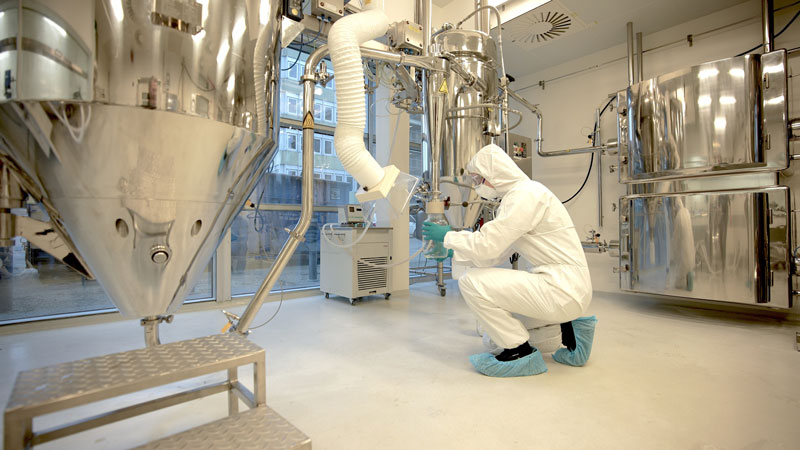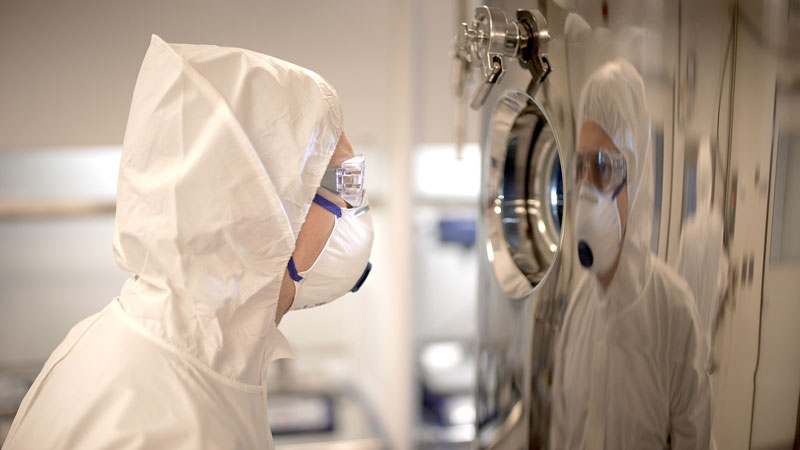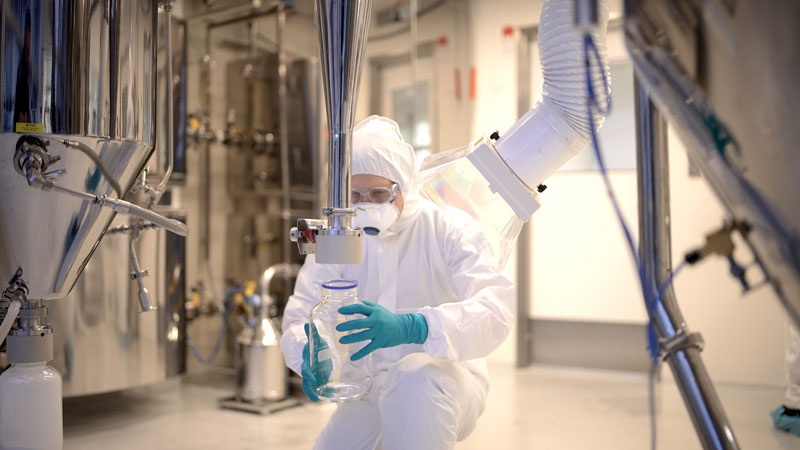Offering tangible benefits that directly enhance patient care, aseptic spray drying is increasingly being recognised as a transformative technology. In terms of how the greater pharmaceutical industry develops and delivers medicines, one of its most significant contributions lies in improving drug stability and extending the shelf-life of active ingredients. By converting sensitive biologics, such as proteins, peptides and vaccines, into dry powders while preserving their integrity, this process reduces the market’s reliance on cold-chain storage and distribution. This not only ensures consistent drug quality but also makes life-saving therapies more accessible in regions where refrigeration is limited.
David Costes, Area Sales Manager at GEA Process Engineering for pharmaceutical spray dryers, observes: “This technology facilitates the formulation of sterile powders for injection, including antibiotics, vaccines, hormones, allergens, monoclonal antibodies, therapeutic peptides, proteins and blood products, as well as powders for parenteral infusions. At GEA, we’re experiencing increased interest in this technology because of its notable advantages.” A chemical engineer by trade with a PhD in biotechnology and 20-plus years of experience, David serves the organisation’s customers throughout Europe and Asia and has contributed to more than 100 pharmaceutical spray drying projects.
For patients, for example, aseptic spray drying can fundamentally improve the treatment experience. Dry powder formulations can be designed for inhalation, oral administration or rapid reconstitution, reducing the need for frequent or painful injections. Such alternatives offer a less invasive approach, making it easier for patients — especially those managing chronic conditions — to comply with their therapy regimes and adhere to treatment plans. Convenience and comfort become powerful enablers of better health outcomes, notes David.
The technology also broadens access to advanced therapies. Stable room-temperature formulations simplify logistics, lower costs and enable medicines to reach remote or resource-constrained areas. This is particularly critical for the vaccines, antibiotics and biologics that are needed in emergency or global health settings; in these situations, rapid deployment and reliable efficacy are essential.
Beyond access and convenience, aseptic spray drying enhances precision in drug delivery. By allowing for the meticulous control of particle size, the technology supports targeted administration, such as delivering medications deep into the lungs for respiratory diseases or via the nasal route for vaccines. This precision not only improves therapeutic effectiveness but also minimises systemic side-effects, thereby contributing to a safer patient experience.
Equally important is the role of aseptic processing in ensuring sterility. By minimising contamination risks without relying on terminal sterilisation, aseptic spray drying upholds the highest standards of patient safety — an especially crucial factor for immunocompromised populations.

Looking ahead
Aseptic spray drying technology creates new opportunities for the future of medicine. It enables the stabilisation of next-generation therapies such as monoclonal antibodies, mRNA-based treatments and other advanced biologics. In doing so, it opens the door to more personalised dosing regimens and needle-free vaccine delivery platforms, helping to accelerate the shift toward more tailored, patient-centred care.
In recent years, says David, we’ve experienced increasing demand for applications that incorporate higher levels of containment. “More than half of the projects we’re working on involve category OEB3, OEB4 and event OEB5 products,” he adds. The second trend affecting the market is data communication and control integration with distributed control systems (DCS). Driven by customer demand, these platforms are becoming ever more complex to meet the industry’s growing needs, especially as greater numbers of large biomolecules (for injection) are reaching the market. In essence, aseptic spray drying represents more than just a manufacturing innovation; it’s a catalyst to improve patient safety, convenience, access and outcomes. By making medicines more stable, easier to use and more widely available, it aligns closely with the evolving needs of patients while shaping the future of modern healthcare.

Elevated innovation in patient-focused drying
In the field of pharmaceutical manufacturing, particle engineering is emerging as a powerful tool to advance drug delivery. GEA has taken this a step further with technologies that allow the precise control of particle characteristics such as size, shape and density. By fine-tuning these attributes using specialised nozzles and adaptable system designs, drug formulations can be optimised for specific applications — whether for inhalable powders, nasal delivery or products that require reliable reconstitution. This not only improves bioavailability but also enhances patient convenience by aligning with the growing demand for precision medicines.
A key strength of GEA’s spray-drying technology, notes David, lies in its ability to protect sensitive biologics. With evaporative cooling, the product is exposed to a lower temperature — typically in the 60–80 °C range — for a very short time (a few seconds) and the collected powder can be cooled immediately. For some applications, even lower temperatures can be used. This preserves biologic activity that might otherwise be compromised. In fact, in some cases, the activity retention achieved surpasses that of traditional freeze-drying methods, making it a valuable solution for next-generation therapies.
Quality and compliance remain central to the company’s approach. GEA’s systems are designed to comply with cGMP requirements and incorporate rigorous safeguards from factory acceptance testing and detailed documentation to calibrated instrumentation and the use of FDA-compliant materials. This built-in assurance ensures product safety and consistency, giving manufacturers confidence in terms of both regulatory alignment and patient outcomes.

A modern alternative to freeze-drying?
As David reiterates, demand for reliable, sterile powders in pharmaceutical manufacturing has never been higher. And although spray drying, per se, has been used for decades, adapting it to aseptic production is opening up new opportunities for efficiency, cost savings and product quality. The most obvious benefit of aseptic spray drying, he says, is that it produces a sterile powder directly. As such, it eliminates the need for post-sterilisation before injection. Compared with traditional approaches such as lyophilisation, spray drying offers several compelling advantages:
- lower operating and capital costs
- faster processing times
- greater control of powder characteristics such as particle size, morphology and consistency.
Spray drying is also an inherently continuous technology, which makes it scale-up compatible for commercial production. Its flexibility allows manufacturers to process a variety of materials, including those that require the evaporation of different organic solvents. From a technical standpoint, aseptic spray drying builds on established principles but introduces critical aseptic protection measures. These include sterilise-in-place (SIP) functionality, pressure vessel construction and the integration of sterile inlet and outlet filters. Filter integrity is tested before and after each run, and powder is discharged within a sterile glovebox to maintain strict aseptic conditions.
Although the concept of aseptic spray drying is not entirely new — specialised plant has been in operation for more than 15 years — it is still perceived to be an emerging technology. Misconceptions remain, particularly that the high temperatures involved will damage sensitive molecules. In practice, this concern is largely unfounded: studies and industrial applications have shown that molecular structure and activity are usually preserved; in some instances, the outcome is even better than with other drying methods.
Of course, says David, aseptic credibility depends on more than equipment design. The validation process is critical, involving rigorous protocols for cleaning, sterilisation, sterile filter testing and powder handling. Steam sterilisation cycles, for example, are verified by temperature and pressure mapping, with bioindicators placed at multiple points throughout the plant to confirm sterility. These measures ensure full compliance with regulatory requirements and instil confidence in both manufacturers and their customers.
In conclusion
Ultimately, aseptic spray drying represents a scalable, practical, validated and cost-effective alternative to lyophilisation, especially for companies using flexible production models. It combines the robustness of an established technology with the precision of aseptic manufacturing, offering pharmaceutical organisations a faster, more agile path to sterile powder production. Still, for APIs that are extremely sensitive or require standard lyophilised formats, freeze-drying remains the trusted standard.
Bibliography
- www.gea.com/en/assets/271680/
- www.gea.com/en/stories/innovating-patient-care-with-aseptic-spray-drying/
- www.pharmtech.com/view/achieving-aseptic-drying-spray-drying-technologies
- www.gea.com/en/products/dryers-particle-processing/spray-dryers/aseptic-sd-spray-dryer/
For more information
David Costes
Area Sales Manager
Pharma Spray Drying
GEA Process Engineering
www.gea.com

